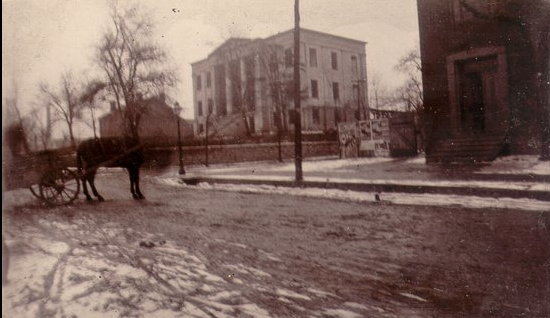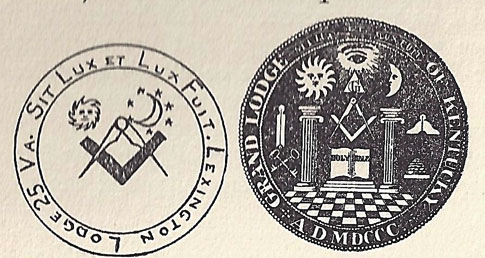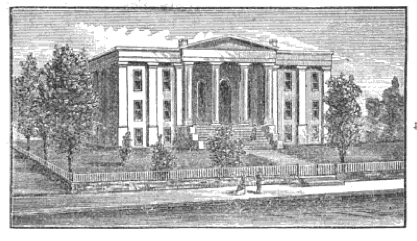The location of Central Christian Church – Short and MLK (nee Walnut) streets – was the site of the first Masonic activities in Kentucky. On April 3, at 5:30 p.m., the historic late 19th century Central Christian Church will be opened for the Blue Grass Trust deTour. More information is available on Facebook. Learn about the location’s history before it was a church below.
 |
| Old Masonic Hall – Lexington, Ky. Source: KDL |
After the fear of Indian attacks was diminished, Lexington began to grow as a community. Soon, the city contained more than pioneering woodsmen but craftsmen and tradesmen. Too came Virginians and others with land grants for their service during the Revolution. With them, came freemasonry. The Masons are a fraternal order which originated in Europe in the late 16th century and the earliest lodges were already operating in Pennsylvania by 1730. And the earliest names associated with Lexington were freemasons: Levi Todd. Robert Patterson. John Maxwell.
 |
| Seals of the Lexington Lodge and the Grand Lodge of Kentucky. Source: Lex. Lodge 1 |
A short collection of Masons assembled in Lexington sought to have a lodge of their order in a location more convenient than across the mountains in the older portion of Virginia. On November 17, 1788, the Grand Lodge of Virginia issued a new charter “at the town of Lexington, district of Kentucke … to Richard Clough Anderson, John Fowler, Green Clay and others to hold regular lodge Free Masons at the town of Lexington, by the name, title and description of the Lexington Lodge No. 25.” It was the first lodge located west of the mountains.
In 1794, a primitive log masonic temple was erected. It was replaced in 1796 by a greater, two-story brick structure at the same site. Soon, the distance from Richmond, Va. again became an issue of impracticality. Though Kentucky achieved statehood eight years earlier, the Lexington Lodge #25 and other regional lodges continued to meet under their Virginia charters. And so in the autumn of 1800, representatives from the various lodges in Kentucky met at the Lexington temple and organized the Grand Lodge of Kentucky. A plaque marks this occasion on the exterior of Lexington’s Central Christian Church.
The old Lexington Lodge #25 was rechartered under the Grand Lodge of Kentucky as Lexington Lodge #1 in recognition of it being the oldest lodge in Kentucky.
A March 1819 fire destroyed the two-story brick temple, whereafter “a sum of money was raised, sufficient to rebuild the lodge hall; and such has been the zeal and activity of the superintendents, that the rafters for the roof, were raised this day. A spacious suite of rooms fifty six by thirty, is being raised, which when completed, will render it one of the most roomy and elegant structures in the city.” (Ky. Gazette, Sept. 3, 1819).
The next five years seem to be a mystery for in 1824, it was decided to build a “handsome building” with “commodious edifice” “which would stand for all ages and should, in some degree, indicate to posterity the state of the arts at he period of its erection.” Due to events described below, I believe this 1824 structure was on a site different than the lodge temples described above which is at Walnut and Short.
Architect Matthew Kennedy oversaw the construction as the cornerstone was laid on July 1 of that year. During construction, Freemason General Marquis de LaFayette visited the city of Lexington and the new temple.
Lafayette, a member of the Masonic Order, was royally entertained by his brethren and citizens of Lexington, and a Masonic Ball was given in his honor in this partially completed building. Lafayette took his seat at the banquet table in front of a large castellated cake, surmounted by the American and French flags, and covered with Masonic designs. This cake was the splendid workmanship of his fellow-countrymen, the well known restaurant-keeper and culinary artist Mathurin Giron, immortalized by James Lane Allen in his “King Solomon of Kentucky.”
After a bounteous repast was served and suitable speeches and toasts for the occasion delivered, the remainder of the evening was devoted to dancing to the strains of Anton Phillipe Heindrick’s masterpieces. The dancing lasted far into the night, but the old general, still lame from the wound he received in the war, was able to tread out but a few of the measures, and left the hall about eleven o’clock “to indulge in those thoughts and feelings which must occupy the mind of such a benevolent man, and which must consecrate his day to peace and happiness, and the day was over for him.”
Next morning, General Lafayette and his suite attended a Masonic breakfast in the grand hall, where he was addressed by John Ward: “Excellent and venerated Brother! Patron of our Country and of National Freedom wherever man exists – The Fraternity of Masons in Lexington greet and welcome you!” General Lafayette’s visit to Lexington was less than two days, yet in that short space he was elaborately entertained in the Masonic Hall on two occasions.
Dedication of the three-story building occurred on October 26, 1826, massively over-budget. A number of lotteries were held to raise funds to pay off the Order’s debts from construction. Dr. Lewis Marshall of Woodford County had the winning ticket in a significant $20,000 lottery. Demanding payment in gold, and sufficient gold not being available to pay the man from Woodford, Marshall was issued a mortgage on the hall. On the mortgage, he foreclosed.
The headquarters of the Grand Lodge of Kentucky was relocated to Louisville in 1833 during Lexington’s cholera epidemic. On August 29, 1835, a fire was found in a carpenter’s shop at the rear of the building. Despite the valiant efforts of several fire brigades, the temple lodge along with her archives, furniture and jewels were lost. All of these events occurred to the detriment of local lodge activity, and all while a national tide of anti-masonry sentiment swept several lodges and some grand lodges from existence. Membership dwindled.
 |
| Lexington Lodge #1. Source: Ranck’s Guide to Lexington. |
Despite all odds, the Lexington Lodge #1 overcame and rebuilt on the site of its original log meeting house. The cornerstone was laid on July 3, 1840 and a the building dedicated September 1, 1841. The fate of this building was unfortunate, as well. Seized by Union forces during the Civil War, it was used as a hospital, recruiting station and eventually as a prison. The building fell into disrepair and could not recover.
The old Masonic Hall fell into disrepair and was demolished in December 1891. Title to the land passed to Central Christian Church whose cornerstone was dedicated in August 1893. Within the cornerstone “contains contents of era” and “is the same piece of rock that came out of the old Masonic Temple.”
Sources: Grand Lodge of KY; Lexington Lodge #1
